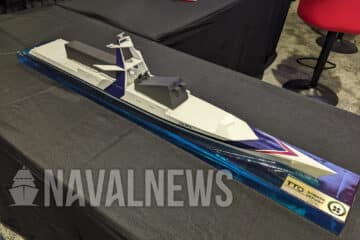Naval News has received a reply from Kelly Flynn, Public Affairs Specialist, Marine Corps Systems Command, Office of Public Affairs & Communication in early June 2022.
Naval News has covered the NMESIS in previous stories found here to include the planned 2023 NMESIS operation date, potential logistics involved in moving NMESIS missiles, and NMESIS training aboard the LHA-7 USS Tripoli.
Each NMESIS carries two Naval Strike Missiles (NSM) containers on a remote-operated unmanned Joint Light Tactical Vehicle (JLTV). The stealthy high subsonic sea-skimming radar-evading NSM has a range of around 100 nautical miles (114 miles/185 kilometers). Readers can look here for more information.
Kelly Flynn said that the USMC’s sought NMESIS production numbers for Fiscal Years (FY) 2022, 2023, 2024, and 2025 are as follows:
- FY22: 10
- FY23: 24
- FY24: 42
- FY25: 32
If fulfilled, that would provide the U.S. Marines a total of 108 NMESIS systems by 2025, or 216 Naval Strike Missiles in ready-to-launch missile containers aboard unmanned JLTVs before requiring reloading.
Kelly Flynn also said that as of June 1, 2022, “Large Scale Exercise 21 was the last exercise NMESIS participated in” and even though the CH-53 heavy-lift military cargo helicopter has lifted a two-door JLTV, the NMESIS system has yet to be seen slung underneath, lifted, and flown by a CH-53.

Metal Shark Long-Range Unmanned Surface Vessel (LRUSV)

On a follow-up to a June 2021 article, Naval News has also asked the USMC Public Affairs on the status of integrating armament such as Loitering Munitions on the Metal Shark Long-Range Unmanned Surface Vessel (LRUSV), not to be confused with the Large Unmanned Surface Vessel (LUSV).
Kelly Flynn replied;
“The Marine Corps is continuing the integration and testing of organic precision firing capabilities [OPF] on LRUSV and working toward an early operational assessment. The Marine Corps’ Long Range Unmanned Surface Vessel (LRUSV) has not participated in any exercises to date.
The Marine Corps OPF program is successfully integrating with the LAV [Light Armored Vehicle] and beginning to integrate with the JLTV.”
Naval News and Author’s Comments
For speculative discussion purposes, integrating organic precision fires (OPF) is vitally important to the U.S. Marines because of the divestment of their M1A1 Abrams Main Battle Tanks (MBT) in order to save money for acquiring these new missile and high-tech Loitering Munition systems. This current approach of shedding heavy USMC Legacy armor systems in favor of lighter, more mobile systems with greater reach and altitude for (top-down) attack supports USMC’s General Berger’s Force Design 2030.
The current war in Ukraine has shown that OPF in the form of drones, Loitering Munitions, Javelin and Next-Generation Light Anti-Tank Weapons (NLAW), and precision guided missiles are deadly effective against Russian MBTs and armored vehicles. The ranges of these lightweight Loitering Munitions, some man-portable, are often greater than the range of a tank cannon. The ability to field OPFs via land and sea provides a capability for the USMC in direct and indirect fire support, especially considering that Loitering Munitions and drones can fly and loiter over a battlefield for hours, providing Intelligence, Surveillance, and Reconnaissance (ISR), before selecting a target to attack, all the while unmanned and keeping the remote pilot ostensibly out of harm’s way.
MBT and armored fighting vehicles have to drive in close to fire their direct line-of-sight tank gun, cannons, and machine guns. The height, range, and flight endurance advantages of utilizing drones and Loitering Munitions provides a double-duty benefit of ISR and top-attack capability to allow the Marines to attack enemy armor and vehicles before these armored vehicles can even get within range to fire and counterattack. The debate on if MBTs are not necessary in future amphibious warfare scenarios is beyond the scope of this story.
The NMESIS unmanned JLTV system provides the U.S. Marines with an effective Anti-Ship “stinger” effect that when teamed with Tomahawk Land-based Anti-Ship Missiles (LBASM) and HIMARS artillery guided rocket systems, develops a layered bubble of area deniability against enemy ships at various ranges. It remains unclear if 108 USMC NMESIS JLTV launchers will be enough to meet future demands and challenges, but NMESIS will definitely provide the Marines a long-range OPF Anti-Ship capability that they never had before, especially considering that the NSM is a “smart missile,” able to fly evasive maneuvers to evade enemy ship radars and specifically target a certain part of an enemy ship. In addition, the USMC is improving their area Air Defense assets to provide cover for their land-based NMESIS, Tomahawk, and HIMARS assets.






